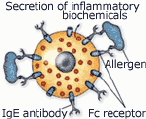|
|
|
What is a Food Allergy?
A food allergy is an immune system response to a food that the
body mistakenly believes is harmful. Once the immune system
identifies a particular food as harmful, it creates specific
antibodies (specific IgE) to it. The next time the individual eats
that food, the IgE attached to a cell (mast cell) stimulates the
release of massive amounts of chemicals, including histamine, in
order to protect the body. These chemicals trigger a cascade of
allergic symptoms that can affect the respiratory system,
gastrointestinal tract, skin, or cardiovascular system. This is an
overreaction of the immune system not a weakness or immune
deficiency. In allergic reactions the immune system is working
perfectly normal. The abnormality is with an error in recognizing
the food protein as foreign.
What are the symptoms of food allergy?Immediate reaction (usually with in 2 hrs, but can happen up to 24hrs after exposure):
Reaction days later: (A mixed reaction or T-cell reaction (no IgE involved )
Are food allergies permanent?Early childhood allergies to milk, egg, wheat and soy resolve in approximately 80%. Peanut allergy resolves in 5% of children by age 5 (it may reoccur) and 20% by teenage years. Typically food allergies with significant reactions (i.e. anaphylaxis) resolve at a much lower rate.
Are all adverse reactions to foods an allergy?Food Intolerances are common-
Most Common Food AllergiesChildren (6%-8% of all children have food allergies):
Adults (4%):
*Sesame seed is now a member of the most common food allergies.
Reactions to Fruits and Vegetables are common (5%) but are usually not severe
A person can be allergic to just about any food.
Many reactions to foods are not an allergy but an intolerance.
|
|
|
Food Allergy
General Information
|
|
|||||
 |
|
 |
|||
|
|



